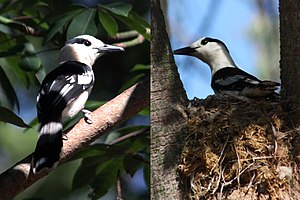Hookbeak vanga
| Hookbeak vanga | ||||||||||||
|---|---|---|---|---|---|---|---|---|---|---|---|---|

Hooked beak vanga (female), right on the nest |
||||||||||||
| Systematics | ||||||||||||
|
||||||||||||
| Scientific name of the genus | ||||||||||||
| Vanga | ||||||||||||
| Vieillot , 1816 | ||||||||||||
| Scientific name of the species | ||||||||||||
| Vanga curvirostris | ||||||||||||
| ( Linnaeus , 1766) |
The Hakenschnabelvanga ( Vanga curvirostris sometimes simply) Hakenvanga called, is a passerine bird of the family of Vangawürger (Vangidae).
features
The hook-billed vanga is a 25-29 cm tall and 53-81 g heavy, black-and-white feathered bird with a white head and black cap, a strong black beak with a characteristic hook at the tip and white stripes on the black wings. Chest and belly are black, in young animals gray, the tail is gray with a wide black band and white tip. Males and females hardly differ.
behavior
The hook-billed vanga feeds on large insects and small vertebrates , including frogs , small birds, bird eggs and chameleons .
distribution and habitat
The hooked beak vanga is endemic to Madagascar . Its habitat are subtropical or tropical dry forests, moist lowland forests and mountain forests , but it can also be found in the vicinity of localities.
The breeding season is between October and January. The birds are monogamous , the nest is built by the male and female together.
The following subspecies can be distinguished:
- V. c. curvirostris ( Linnaeus , 1766) as a nominate form in the north, west and east of Madagascar
- V. c. cetera Bangs , 1928, in the south of Madagascar with a slightly longer beak, a shorter head cap and a wider white neck band
Hazardous situation
The stock is not considered to be at risk ( least concern ).
Individual evidence
- ^ A b F. Hawkins, R. Safford, A. Skerrett: Birds of Madagascar and the Indian Ocean Islands. Helm Field Guides, 2015, ISBN 978-1-4729-2409-4
- ↑ a b c d Handbook of the Birds of the World
- ^ IUCN Redlist Vanga curvirostris in the IUCN Red List, accessed on December 31, 2016.